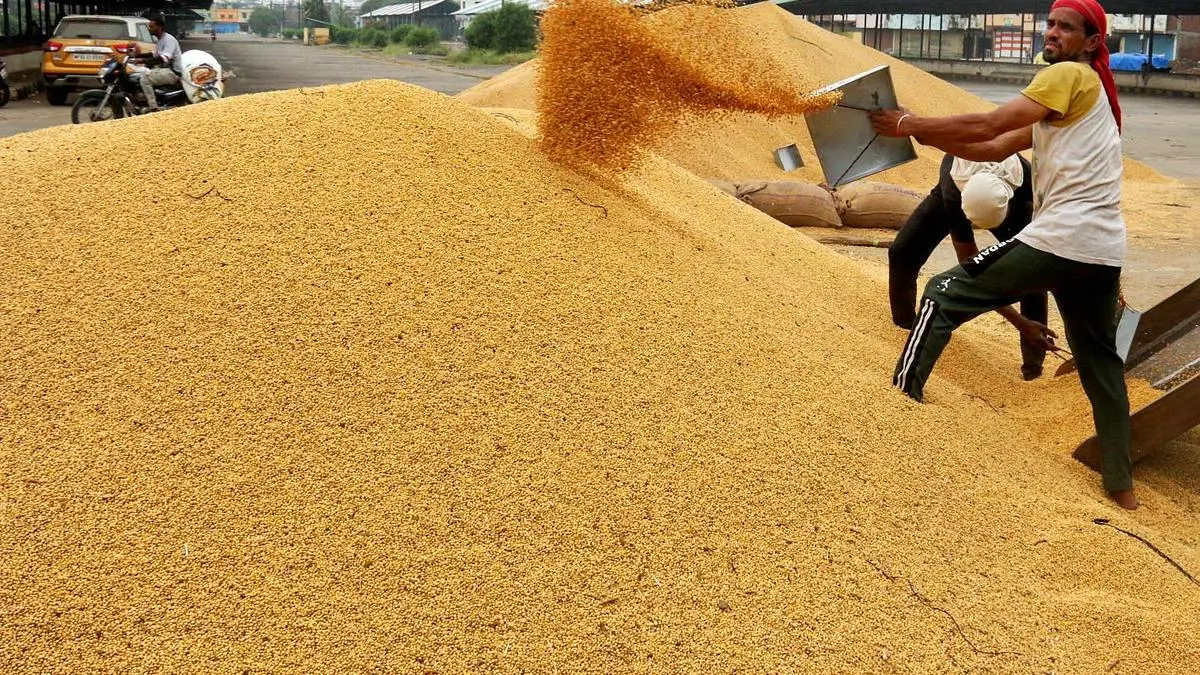
Bhopal, Oct 26 (ANI): Labourers sort newly harvested soybean crops at a wholesale grain market, in Bhopal on Saturday. (ANI Photo)
| Photo Credit:
ANI
The United States’ move to sell $1 billion worth of soybeans to Bangladesh is set to impact India’s soymeal exports to the neighbouring country, triggering fresh concerns among exporters who already witnessed a slowdown in shipments during the oil year 2024–25, which ended in September.
Bangladesh has traditionally been one of the largest buyers of Indian soymeal. However, shipments during 2024–25 saw a sharp decline to 1.63 lakh tonnes, down 46 per cent from the previous year’s 3.02 lakh tonnes.
“Bangladesh is importing a lot of soybean at cheap prices from the US, which resulted in a drop in exports during the 2024–25 oil year. They have just signed a big contract with the US to buy $1 billion worth of soybeans, which obviously means they will not buy from India — and that’s a concern,” said DN Pathak, Executive Director, Soybean Processors Association of India (SOPA), the apex trade body.
On Tuesday, the US Embassy in Dhaka announced that a consortium of Bangladesh’s three leading soya-crushing companies had committed to purchase $1 billion of US soybeans over the next 12 months. The deal is significant as the US has been scouting for alternative markets to offload its soybeans after China, a major buyer, halted purchases in recent months amid escalating trade tensions and retaliatory tariffs imposed by the Trump administration.
According to reports, Beijing recently announced it would lift certain tariffs on farm goods from November 19 but retain a 13 per cent duty on US soybeans, keeping them less competitive compared to South American supplies.
Weak Export Outlook
The latest developments are expected to weigh on Indian soymeal shipments in the year ahead. “The export outlook right now doesn’t look very good. The situation is fluid — it’s difficult to say how much we’ll be able to export,” Pathak said, commenting on prospects for the 2025–26 oil year. “It all depends on how global prices behave. If prices rise further, we may turn competitive,” he added.
Indian soymeal remains costlier in global markets because it is non-genetically modified (non-GM). Typically, Indian meal is outpriced by around $100 per tonne compared with GM soymeal.
During the oil year 2024–25, Indian shipments fell 5 per cent to 20.23 lakh tonnes, down from 21.28 lakh tonnes in the previous year, mainly due to reduced offtake from countries such as Iran and Bangladesh.
However, robust demand from European buyers — primarily Germany, France, and the Netherlands — helped offset the decline. “European demand was strong as buyers covered their positions ahead of the rollout of the European Union Deforestation Regulation (EUDR) norms,” Pathak said.
Exports to Germany rose fourfold to over 4.10 lakh tonnes (from 1.04 lakh tonnes), while shipments to France tripled to 2.23 lakh tonnes (from 68,332 tonnes). Exports to the Netherlands more than doubled to 1.11 lakh tonnes (from 50,856 tonnes).
Pathak attributed the fall in shipments to Iran to the prevailing geopolitical situation. “Iran always faces issues with foreign exchange payments, and sanctions make trade risky. Exporters don’t want to take chances dealing with Iran under these circumstances,” he added.
Meanwhile, the Indian soymeal industry is preparing to meet the upcoming EUDR compliance requirements. “We’re working very hard on several aspects. I think we should be able to comply with EUDR and continue exports. The Madhya Pradesh government is helping us a lot in meeting these regulations,” Pathak said.
Published on November 5, 2025
